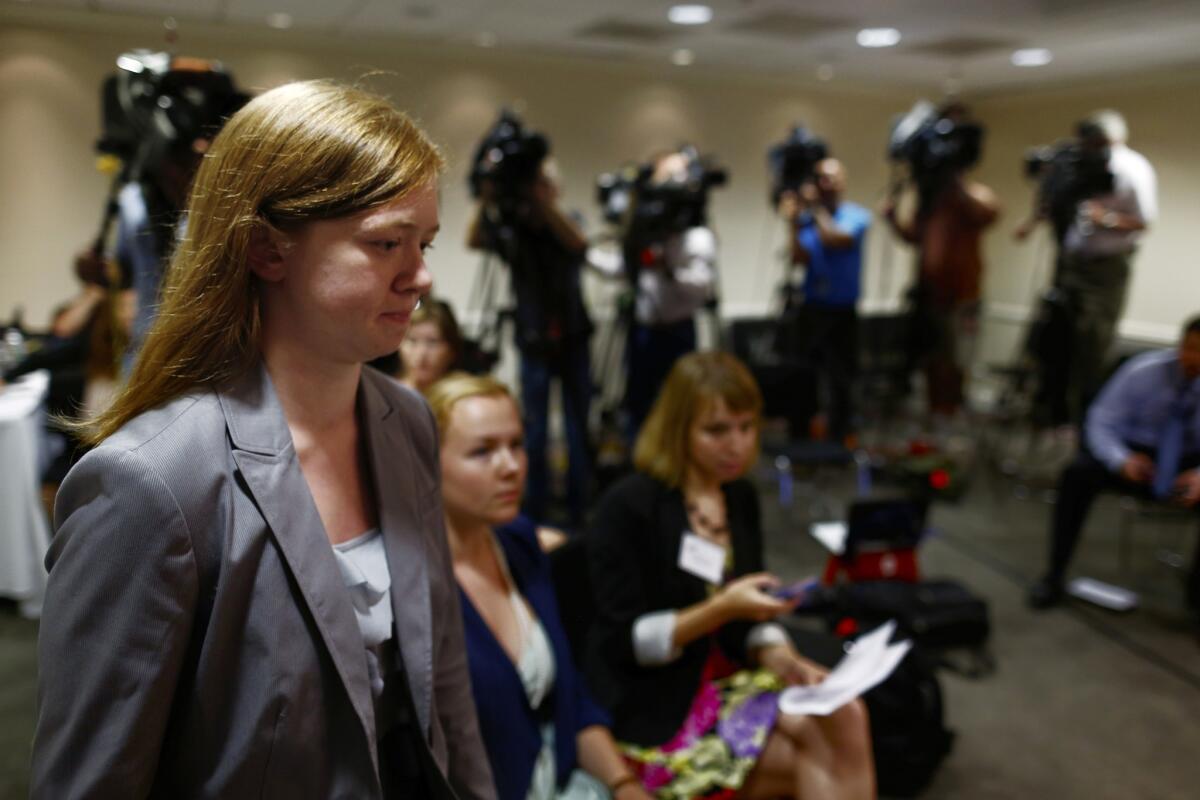Op-Ed: Texas’ college admissions policies give the well-to-do a leg up

Abigail Fisher, who sued the University of Texas when she was not offered a spot at the university’s flagship Austin campus in 2008, arrives for a news conference at the American Enterprise Institute on June 24, 2013.
- Share via
Morally and politically, the well-off minority student has always been the Achilles’ heel of colleges’ affirmative action programs. Most people agree that applicants who have overcome economic odds deserve a leg up. But as President Obama has acknowledged, daughters like his — who have grown up with privilege — don’t need preferential consideration when applying to college.
Yet it is privileged minority students who are at the center of Fisher vs. University of Texas II, which will be argued before the U.S. Supreme Court on Wednesday. The University of Texas at Austin’s legal defense is that it needs to admit “the African American or Hispanic child of successful professionals in Dallas” so as to dismantle stereotypes that all blacks and Latinos are poor.
As President Obama has acknowledged, daughters like his -- who have grown up with privilege -- don’t need preferential consideration when applying to college.
That middle to upper-class minority students benefit most often from race-based selection was the embarrassing little secret of college admissions. How did it morph into a legal virtue?
The story began in 1996, when the 5th Circuit Court of Appeals struck down the use of race in admissions in Hopwood vs. Texas. In response, the Texas Legislature enacted what’s called the “top 10% plan,” under which anyone graduating at the top of his or her high school class earned admission to any public university in Texas — including the flagship, UT Austin — irrespective of SAT or ACT scores. That plan turned the de facto segregation of Texas’ high schools into a source of vibrant racial and ethnic diversity at its public universities.
Over time, the top 10% plan produced a freshman class at UT Austin with as many black and Latino students as the flagship campus had achieved using explicit racial preferences in the 1990s. The 10% plan also had opened the door to economically disadvantaged students in a way that racial affirmative action had not.
UT started using racial preferences again, however, after the U.S. Supreme Court negated Hopwood in a 2003 case from the University of Michigan. Since then, about three-quarters of students at UT Austin have been admitted through the 10% plan, and the rest through discretionary admissions that take race into account.
Abigail Fisher, a white student denied entry to UT in 2008, sued. The case wound its way to the Supreme Court, which in 2013 sent it back to the 5th Circuit with instructions to strictly scrutinize whether race preferences in admissions were really “necessary.”
Surprisingly, the 5th Circuit backed using racial preferences. Rather than note the success of the top 10% plan at achieving socioeconomic diversity, the court faulted it for failing to admit more well-off students of color from affluent integrated high schools whose “experiences of being a minority in a majority-white” school would add value. The court’s opinion appeared to echo UT’s argument that students admitted outside the top 10% program were more likely “to have attended an integrated high school” and therefore “have great potential for serving as a ‘bridge’ in promoting cross-racial understanding.”
This argument is problematic on several levels. First, well-off minority students are hardly absent on selective campuses, where roughly 9 in 10 black students are middle- or upper-class. Even in the absence of race-based affirmative action, about one-third of current black and Latino students would have been admitted based on academic credentials, and a disproportionate share of them are affluent.
In addition, if universities are specifically seeking students who are bridge-builders, preferences for privileged students of color are an unnecessary and blunt instrument. Instead, students of any race who have fostered interracial dialogue could receive special consideration. Indeed, there is evidence that because low-income whites have more experience interacting with minority students in high school, they are more likely than other whites to engage with students of other races during college. Yet careful research suggests that admissions officers provide no boost to disadvantaged whites.
UT’s argument that admissions policies should benefit privileged students of color is precisely the opposite of the race-blind class-based approach advocated by the Rev. Martin Luther King Jr. In his 1964 book “Why We Can’t Wait,” King wrote that compensation is due to black Americans. But instead of urging adoption of a program exclusively for black people, as some civil rights leaders had done, King called for a racially inclusive Bill of Rights for the Disadvantaged.
Universities, however, would much rather admit wealthy students than disadvantaged strivers of any race. Only when racial preferences have been banned, usually by voter initiative, have universities adopted class-based affirmative action programs to indirectly promote racial diversity. If the Supreme Court rejects UT’s argument, King’s idea of need-based affirmative action may, 50 years later, finally see widespread adoption.
Richard D. Kahlenberg, a senior fellow at the Century Foundation, is editor of “The Future of Affirmative Action: New Paths to Higher Education Diversity after Fisher v. University of Texas.”
Follow the Opinion section on Twitter @latimesopinion and Facebook
More to Read
A cure for the common opinion
Get thought-provoking perspectives with our weekly newsletter.
You may occasionally receive promotional content from the Los Angeles Times.









